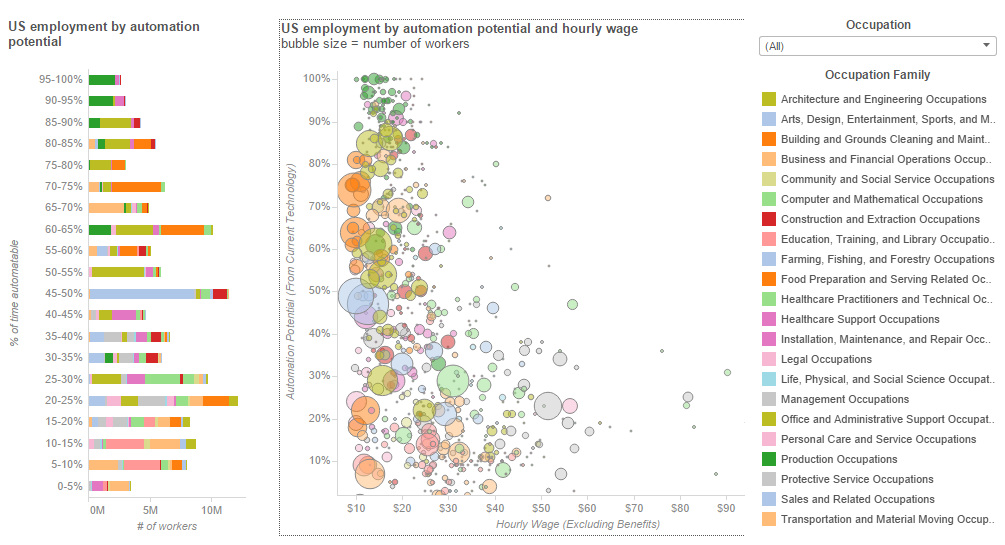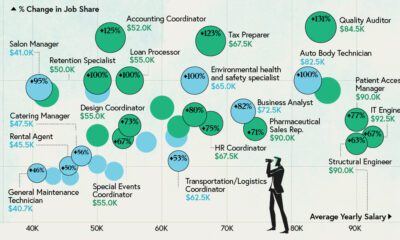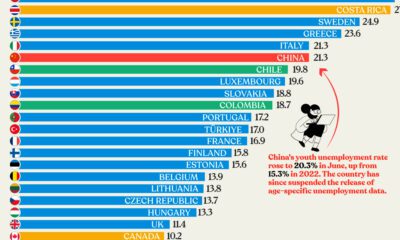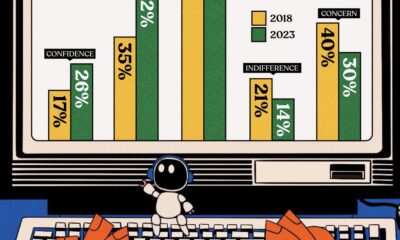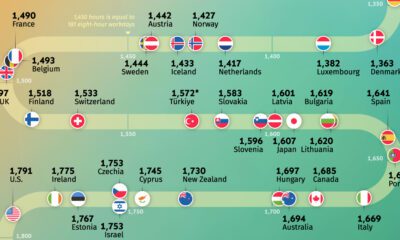Technology
Charting the Automation Potential of U.S. Jobs
Charting the Automation Potential of U.S. Jobs
In last week’s Chart of the Week, we noted that 1.3 million industrial robots would be installed between 2015 and 2018, and this would more than double the stock of active robots around the world.
While many of those robots will be used in the automotive and electronics sectors, there are many other roles that robots will be filling in the future. Surprisingly, according to global consultant McKinsey & Co, not all of these jobs are low-skill, low-wage jobs, either.
Mckinsey ran a comprehensive study of nearly 800 different jobs in the United States, ranging from CEOs to fast food workers. Between these roles, they found 2,000 individual work activities, and assessed them against 18 different capabilities that could potentially be automated. In their analysis, they found that 45% of work activities representing $2 trillion in wages can already by automated based on proven technology that currently exists. A further 13% of work activities in the U.S. economy could be automated if the technologies used to understand and process human language were brought up to the median human level of competence.
Who’s in, Who’s Out?
The interactive visualization above charts specific careers on their automation potential (out of 100%) along with the hourly average wage of the job.
What is most interesting about the analysis is that automation potential doesn’t correlate with low-skill, low-wage jobs as much as one may think. While it’s true that the three million fast food workers across the country have an automation potential of 74%, and that heavy truck driving activities can be 69% automated, there are also great counter-examples: for example, only 7% of manual labor and 22% of janitorial activities could be automated.
Likewise, high-paying jobs are not necessarily robot-proof.
Doctors (23%), nurses (29%), and even CEOs (25%) all have significant amounts of their jobs that can be automated with current technology. Almost half (47%) of what pharmacists do can be done by a robo-pharmacist, and 72% of commercial pilot activities can be done through computers.
Not interested in having a robot fill your shoes? Mckinsey notes at the end of their analysis that both creativity and sensing emotion are extremely difficult to automate. Focus on building skills and competencies in these categories, and you’ll be just fine (for now, at least).
Brands
How Tech Logos Have Evolved Over Time
From complete overhauls to more subtle tweaks, these tech logos have had quite a journey. Featuring: Google, Apple, and more.

How Tech Logos Have Evolved Over Time
This was originally posted on our Voronoi app. Download the app for free on iOS or Android and discover incredible data-driven charts from a variety of trusted sources.
One would be hard-pressed to find a company that has never changed its logo. Granted, some brands—like Rolex, IBM, and Coca-Cola—tend to just have more minimalistic updates. But other companies undergo an entire identity change, thus necessitating a full overhaul.
In this graphic, we visualized the evolution of prominent tech companies’ logos over time. All of these brands ranked highly in a Q1 2024 YouGov study of America’s most famous tech brands. The logo changes are sourced from 1000logos.net.
How Many Times Has Google Changed Its Logo?
Google and Facebook share a 98% fame rating according to YouGov. But while Facebook’s rise was captured in The Social Network (2010), Google’s history tends to be a little less lionized in popular culture.
For example, Google was initially called “Backrub” because it analyzed “back links” to understand how important a website was. Since its founding, Google has undergone eight logo changes, finally settling on its current one in 2015.
| Company | Number of Logo Changes |
|---|---|
| 8 | |
| HP | 8 |
| Amazon | 6 |
| Microsoft | 6 |
| Samsung | 6 |
| Apple | 5* |
Note: *Includes color changes. Source: 1000Logos.net
Another fun origin story is Microsoft, which started off as Traf-O-Data, a traffic counter reading company that generated reports for traffic engineers. By 1975, the company was renamed. But it wasn’t until 2012 that Microsoft put the iconic Windows logo—still the most popular desktop operating system—alongside its name.
And then there’s Samsung, which started as a grocery trading store in 1938. Its pivot to electronics started in the 1970s with black and white television sets. For 55 years, the company kept some form of stars from its first logo, until 1993, when the iconic encircled blue Samsung logo debuted.
Finally, Apple’s first logo in 1976 featured Isaac Newton reading under a tree—moments before an apple fell on his head. Two years later, the iconic bitten apple logo would be designed at Steve Jobs’ behest, and it would take another two decades for it to go monochrome.
-

 Maps1 week ago
Maps1 week agoThe Largest Earthquakes in the New York Area (1970-2024)
-

 Money2 weeks ago
Money2 weeks agoWhere Does One U.S. Tax Dollar Go?
-

 Automotive2 weeks ago
Automotive2 weeks agoAlmost Every EV Stock is Down After Q1 2024
-

 AI2 weeks ago
AI2 weeks agoThe Stock Performance of U.S. Chipmakers So Far in 2024
-

 Markets2 weeks ago
Markets2 weeks agoCharted: Big Four Market Share by S&P 500 Audits
-

 Real Estate2 weeks ago
Real Estate2 weeks agoRanked: The Most Valuable Housing Markets in America
-

 Money2 weeks ago
Money2 weeks agoWhich States Have the Highest Minimum Wage in America?
-

 AI2 weeks ago
AI2 weeks agoRanked: Semiconductor Companies by Industry Revenue Share


